Okie-Tex Star Party 2007
by Mike Lockwood (photos and text Copyright 2007)
I thought for a while and tried to come up with one word that described
this star party, this journey, this experience, and I couldn't come up
with one. There was simply too much involved to distill it down
to a single word. So, in this article I'll attempt to convey some
of what we experienced going to, attending, and returning from Okie-Tex 2007.
The journey began around 10:45pm on Sunday night, as we slowly headed
for the interstate in Mike Conron's minivan, towing a trailer
containing a 30" telescope
and lots of other stuff we chose to bring along. I drove the
first shift, which took us through St. Louis to central Missouri, where
Mike C. took over the driving. We drove around a very rainy and
surprisingly busy Kansas City around 6am, and we discovered that their
interstates were in need of MUCH more reflective paint, because it was
very, very difficult to see the lane lines on the road! Anyway,
we made it around KC safely, daybreak came,
and we finally saw the flatlands of Kansas, the first time I had been
in
the state. After breakfast in a small town, we made our way
towards Wichita, and I took my first photos of the journey in the very
beautiful Flint
Hills.
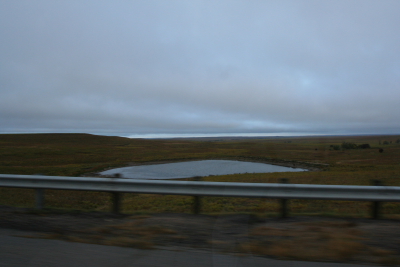
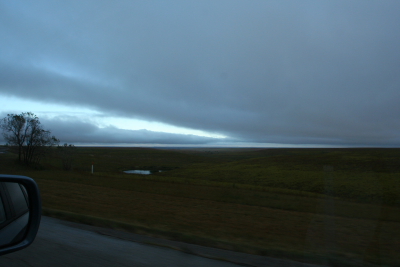

The subtle colors, as the sunlight ate away at the clouds, were quite
beautiful, and we nearly had the road to ourselves. As we drove
on, the clouds finally disappeared, and we found ourselves on straight
roads in bright
sunshine under a beautiful blue sky. After some time we stopped
and
Bob Nonnemann, the third member of our expedition, took his turn
driving.
Soon afterward we found ourselves passing through Greensburg, Kansas,
which has been hit
recently by an F5 tornado. Some photos of what
was left of the town are shown below, including a tent that was serving
as a hospital.
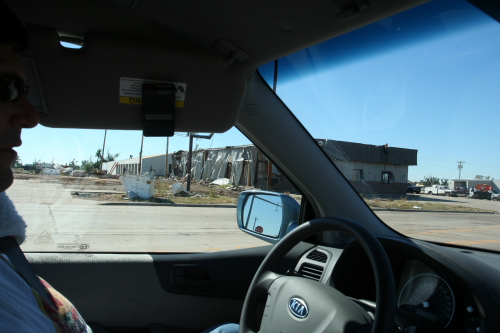
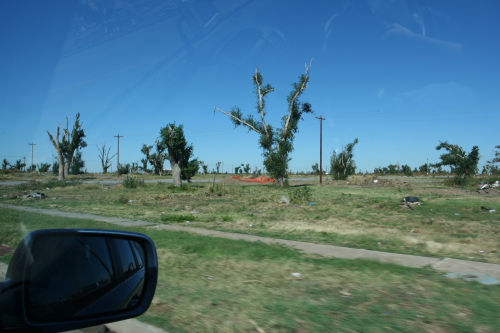
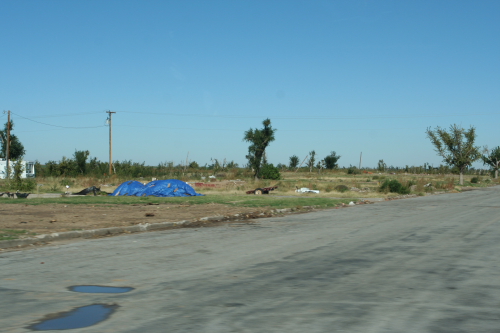
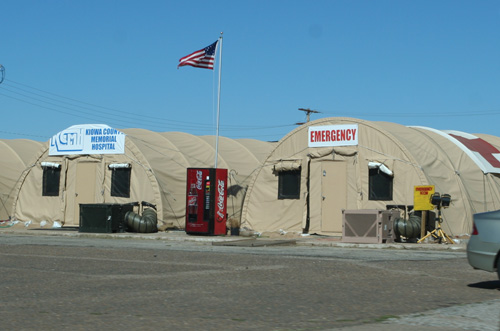
After this, we passed town after small town. Finally, we came to
Liberal, and were unimpressed. On increasingly bumpy road, we
drove on through towns with
names
such as Hooker, and finally passed Boise City and left most of
civilization
behind as we drove through flat scrub land. We observed a fire
well off in the distance, probably somewhere in Texas or New Mexico, as
we
counted down the miles until we reached Camp Billy Joe. The camp
is only a few miles from New Mexico and Colorado, in the extreme
northwest corner of the panhandle of Oklahoma.

Finally, the topography began to change. Mesas began to appear on
the horizon, and cacti were visible. The land was transforming
from that of the arid plains to that of higher lands worn down by time
and the elements. At last the arid, flat landscape had some
structure and
points of interest. The road went up and down a few hills.
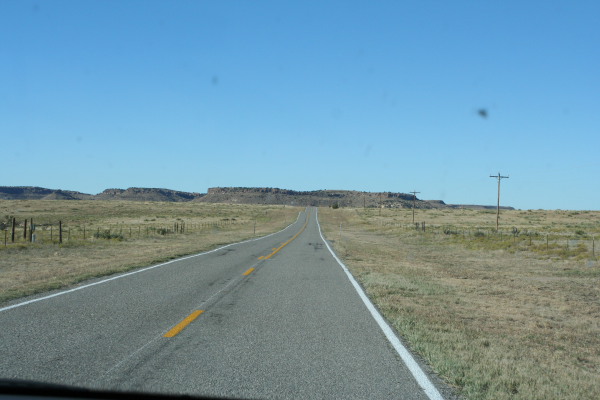
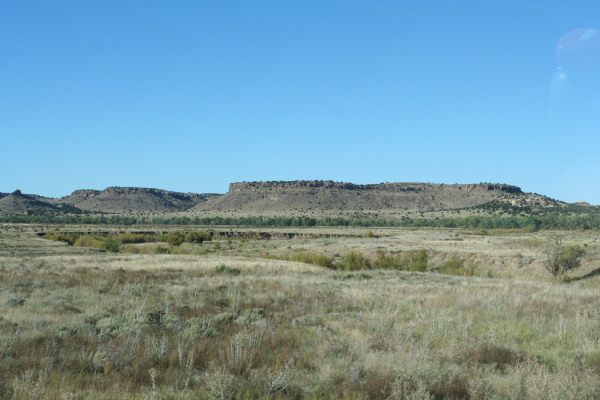
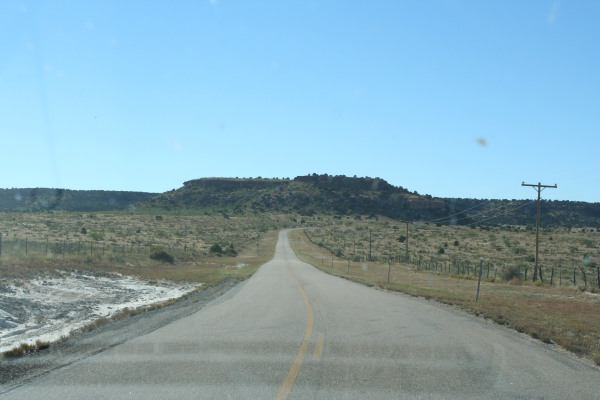
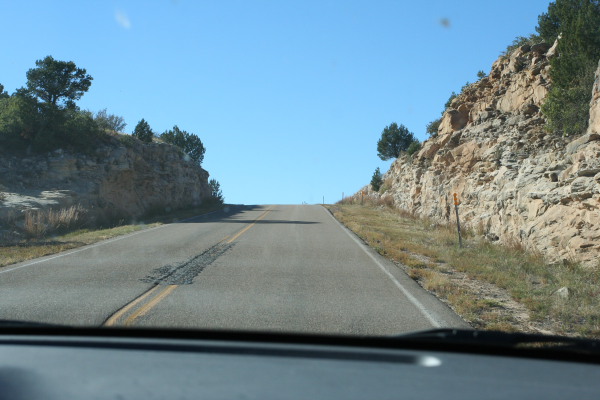
Finally, across the plain we saw a great gathering of vehicles and RVs,
and there it was, a good sized star party under clear blue skies.
What more could you ask for? It was nearly dinner time, so
after 975 miles and an overnight drive, we parked the vehicle and
headed up for our first meal at the camp. After some good food,
we set up camp and our 30" F/3.8
telescope. Here's a photo of Mike and Bob in our camp area.

Setting up the scope was not without an unsettling event. As we
dragged the mirror box toward the back of the trailer as we had done
countless times before, the trailer hitch popped off of the ball!
We quickly grabbed the trailer, secured it again and set up the
scope, but this event highlighted a problem we figured out the next day
- the trailer Mike had bought (from Farm and Fleet in Urbana, IL) was
equipped with the wrong parts installed in the hitch! With the
scope set up, and I
decided to take a shower.
After I was clean, we settled in to await the darkess. We chatted
with Bob Kirschenmann and I handed him a box, which contained a 12.5"
F/4.9 mirror that I had just finished refiguring for him. We met
the people camped near us, and watched the setting sun cast shadows on
the ridge to the
east, and in the atmosphere above us. The sky was quite clear,
but
a very slight haze was present in the atmosphere. However, at
nearly 4500 feet, the location was far clearer than the vast majority
of dry winter nights in central Illinois.
As darkness finally fell, we noted the changes in the sky, comparing
the appearance of it to various observing locations. First, we
noted when the sky was as dark as viewed from my driveway, in urban
Champaign, IL, where bright stars are visible. Soon afterward it
was as dark as our viewing site southwest of town (on a good night).
Not too much later it was as good as our darkest nearby observing
site, and then as dark as the sky at the Illinois
Dark Skies Star Party (2006 page), (my
IDSSP06 page is here), an excellent site about two hours west of
Champaign. Of course, it continued to get darker after this.
When it was truly dark, the sky was as close to what I remember seeing
in my childhood as any place I have been since. I grew up in the
woods in northern Michigan, where light pollution was nearly zero and
the air was wonderfully clean and transparent..... but I didn't
have access to a
30" telescope then! The Milky Way was brilliant overhead, truly
radiating with the glory that was meant to reach our eyes before the
skies began to be taken from us by "developers" and other greedy
purveyors of subdivisions who tell us our yards must be eternally
lit...... end rant. As a teenager, I distinctly remember the
Cassiopeia-Perseus region rising over the trees in northern
Michigan. It was just ablaze with countless stars, and I got
nearly the same impression at Okie-Tex.
We eagerly gobbled up photons with our big scope, catching all of the
highlights in Sagittarius before it set over the canyon wall to the
southwest. The weather was delightful - a bit cool, but not at
all cold until later on. There
were no mosquitoes and few bugs at all. Crickets chirped on the
ridge.
The sky was not black, but showed a bit of a grayish-brown tint,
due
to skyglow and dust/haze in the atmosphere. However, let me
assure
you that it was an exceptionally dark sky. On this very dark
background
lay a multitude of faint stars that made star hopping a breeze.
We
were all tired, but we managed to stay up until 2am when Orion rose,
and
Bob and I got a nice look at M42 and the Horsehead before we crawled
into
our sleeping bags. The temperature had dropped a bit, so as soon
as
I got warm I quickly fell asleep. I had slept very little the
night before, but I didn't care. We had already gotten our
money's worth.
Tuesday dawned bright and sunny, and I slept well past breakfast (which
I really wish was served later). I had a snack, and I convinced
Bob
and Mike to climb the ridge to the east. We wound our way up the
slope, and found a route onto the top of the massive rocks that lined
the top of the ridge. The pink flamingos greeted us as we
surveyed the camp from above. The flamingos appeared to be
wearing cell phone cases, and this was a good hint that this was a good
place to have hope of getting reception.
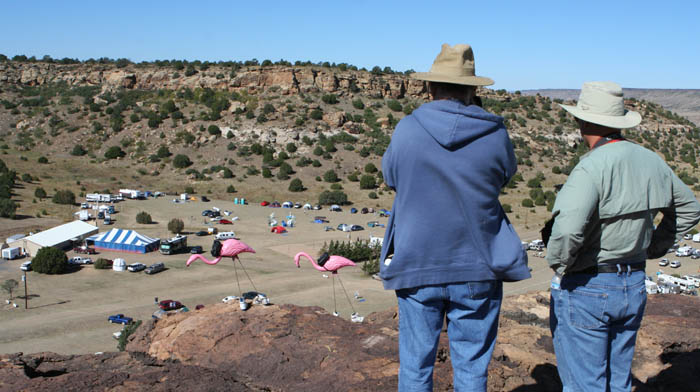
As we were enjoying the view, the lunch bell rang a bit early, and
being quite hungry we descended back to camp and had lunch. I
think this afternoon
Mike and Bob made an expedition in search of the correct trailer parts.
We borrowed tools from Bob K. and disassembled the hitch, and
they headed off in search of parts and to check out other sights in
northwest New Mexico.
After lunch Bob K., his friend Tom, and I went just north of the camp
to see the dinosaur tracks that were near the trailhead for the Black
Mesa trail. This is part of Black
Mesa State Park, I believe. Here are Bob and Tom with the
tracks after Bob did his best to clean them out with an ice scraper.

After we all returned to the field, Mike and Bob were back with trailer
hitch parts. We again looked at the hitch situation. I went
around the field, explaining our situation, and asking to look at
properly
assembled trailer hitches to make sure all the parts were there and
installed
in the proper order.
Venturing over to one nearby trailer, I looked underneath, and I
noticed that the hitch was locked, but it was sitting on TOP of the
ball, rather than
being locked to it. Assuming this was intentional, I asked the
owner
if we could unlock the hitch and latch it around the ball. He
said
"It is latched to the ball." I responded "No it isn't." He
said,
"Yes, it is." I said "I'm sure it isn't, you better take a look".
He
promptly kneeled down to inspect it. A look of profound surprise
(with
just a touch of horror) appeared on his face, as he realized how lucky
he
was to have made it to the star party without having the trailer become
separated
from his vehicle. I like to think that our trailer problems were
not
so much meant to teach us a lesson about trusting high-schoolers to
assemble
a trailer hitch properly, but were meant mainly to cause us to discover
the
even bigger problem that this guy had, and maybe to save him from a
serious
accident and equipment damage on the way home.
After more encouraging trailer stories (like Bob K. telling us about
the time he was sold a trailer that, unbeknownst to him, had car tires
on it rather
than the proper type of trailer tire, which resulted in a serious
accident),
Mike Conron found a way, using some of the parts from the new hitch, to
secure
the trailer to the ball so that we were sure it would not come off.
The
locking mechanism looked like it was unlocked, but the mechanism was
actually
secured with a locknut, and it couldn't be released without a ratchet
and
socket! That hack got us safely home.
Anyway, Tuesday night came, also clear, and we settled in for another
night of observing. I believe it was on this night that I got out
my camera and mounted it piggyback on our 30" telescope while it was
not being used. I took images of the Milky Way in the southwest,
later in the northwest, and rising in the east. A couple of the
better ones are shown below. The first is the southern Milky Way,
the second star trails around the
pole, and the third is Auriga and Taurus rising over the ridge in the
east.
This was my first real attempt at taking any astrophotos.
It was
fun, and let me record some of the quality of the sky for others to
see. However,
I suspect I'll always be a visual observer at heart.
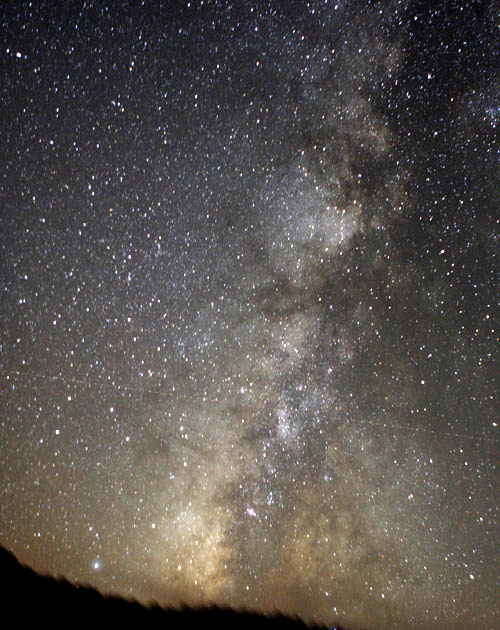
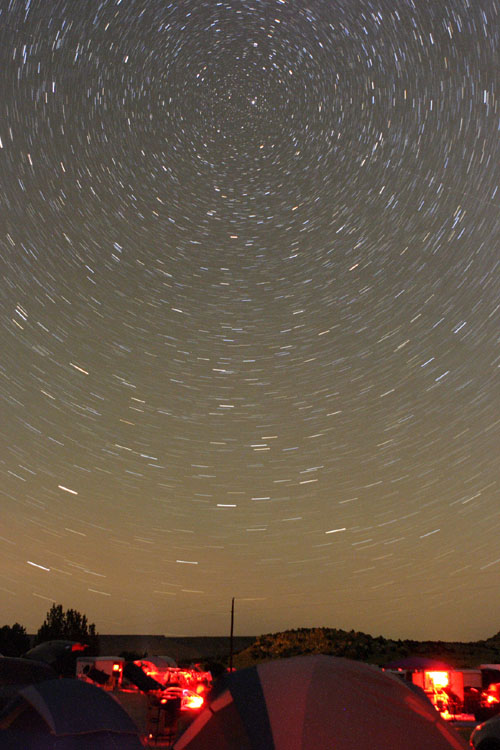
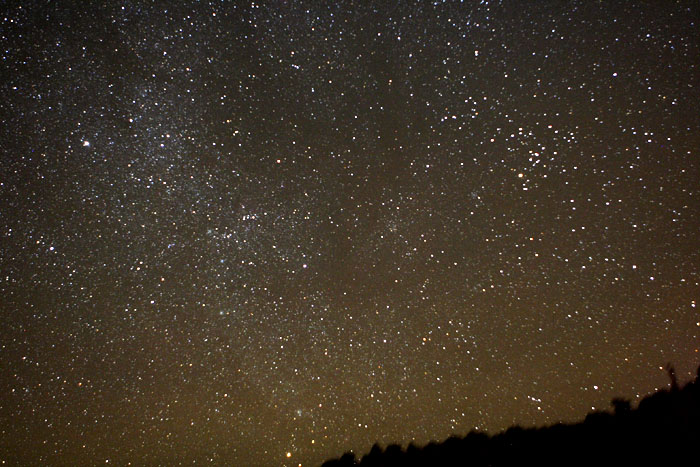
On this second night I used the telescope I had brought along - my 8"
F/3.9 (also the first mirror I made) - much more seriously. Large
objects, such as the California, North American, and Rosette nebulas,
were picked off quite easily. Some IC objects near Cassiopeia
also were easily visible. An OIII and H-Beta filter were
used. The entire Veil fit (just barely) in a 31mm Nagler, and the
middle portions were there too. The Crescent (NGC 6888) showed up
quite well. M27 was beautifully defined on a black
background. The star clouds in Scutum and Sagittarius were
beautiful beyond belief, and scanning the Milky Way anywhere was a
ridiculous amount of fun. M33 and M31 were amazing - they just
kept on going out of the field. The winter Milky Way was
beautiful, and I looked at the brighter nebulous areas in Orion (M78,
M42, the Flame) by just scanning around. My only regret is that I
didn't look for some dark nebulae on the Barnard list.
I didn't think it could get much better, but then it did.
Late this night I noticed a mysterious brightening of the sky to the
south and east of the square of Pegasus. Others, when asked to
describe what they saw without me telling them what I saw, described
the same brightening. It was fainter than the Milky Way, but
bright enough to easily be seen with averted vision. I realized
that this could only be the gegenschein, a
bright area of sky opposite the sun. It was late, after 3am, but
I nearly ran to my tent, grabbed my camera, and affixed it once again
to the 30", opening the shutter for a 3-minute and 5-minute exposure.
Below is a processed image,
with the brightness stretched to approximate what I recall seeing with
my
eye. The bright area is exactly where I remember it, and it is
not
symmetric, so it is not due to vignetting in the camera. I
believe that I really did record an image of the gegenschien.
Part of the great square
of Pegasus lies in the upper right of the image, and the glow is
centered on two stars in Pisces (epsilon and delta), almost exactly
centered on the ecliptic, where it is expected to be. A plane or
tumbling
satellite is visible at the bottom. I do not recall noticing the
reddish
glow at lower right visually (which may or may not be visible on your
monitor -
is on mine), and I don't know what it is.
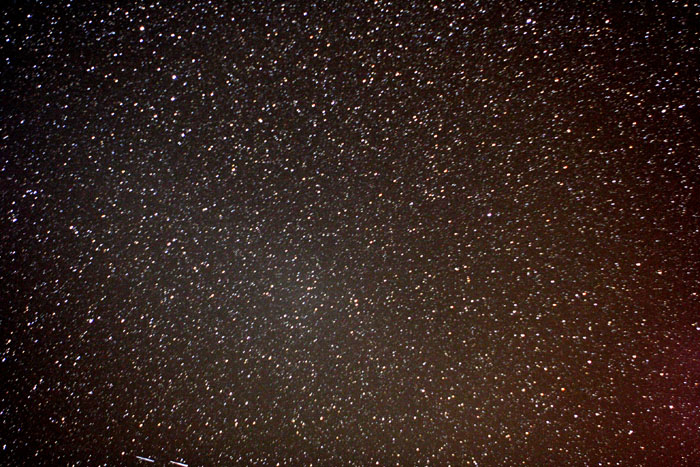
Wednesday dawned with fog around, and the sun mercilessly beat it back
into the nearby mesas. We relaxed in the morning, and then
decided to head to the Capulin
volcano after lunch. As we approached it we could see some
showers in the distance (first photo below), and we drove up the road
to the crater. Up there at nearly 8200
feet it was breezy and cool. Rain showers were around us (other
photos
below), but miles off. Bob and I hiked the trail around the rim
of the crater with some haste
to make sure we got around it before any showers and lightening reached
us. It was a good workout, and a spendid view.
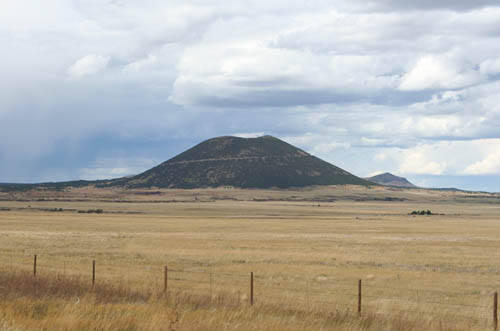
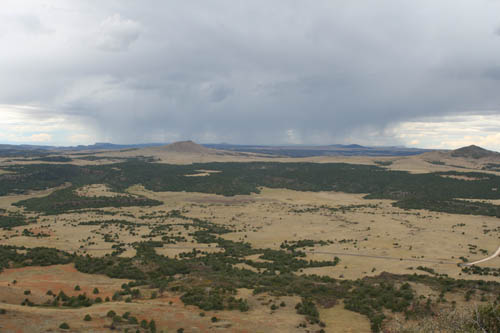
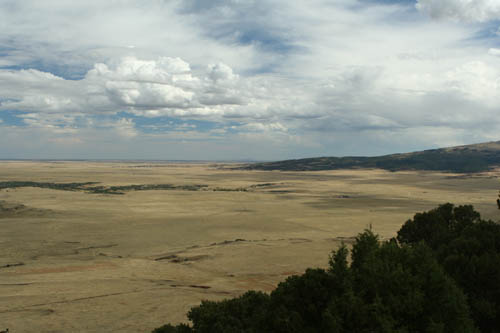
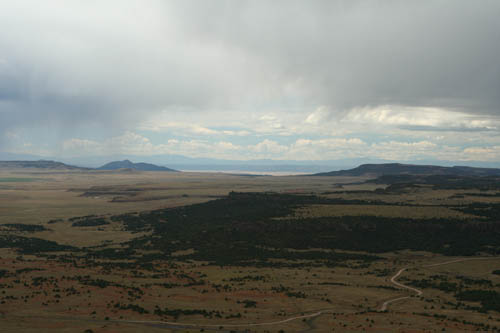
As we drove back to the star party, the showers followed us. We
drove through some rain while still in New Mexico, and it looked like
the showers would make it back to the camp. However, when we got
back, just in time
for dinner, it got cloudy, but then it cleared. After dinner we
watched
the storms drift to the east. Lightening flashes were visible as
it
got dark, and once again I grabbed my camera and captured some of the
action.
For several hours afterward lightning flashed in the distance and
caused
the whole sky to strobe. Below is a fairly striking image taken
as
the storm was going behind the ridge to the east. (I also have a
sequence of images of lightening flashing in the distance and stars
rising behind the storm that I intend to make into an animation and
post here later on.)

Wednesday night was another beautiful night. They all sort of
blurred together after a while. As I recall some high clouds came
in and we turned in not too long after midnight.
Thursday was beautiful again. I chatted with Rick Singmaster and
Bob in the morning, and after lunch Tom and I hiked up the ridge behind
the camp and onto the ridge to the west of camp. We crossed to
the other side and were treated with a nice view of the small town of
Kenton. Below is a view of the camp from the ridge to the
southwest. Note the slight haze visible on the horizon.
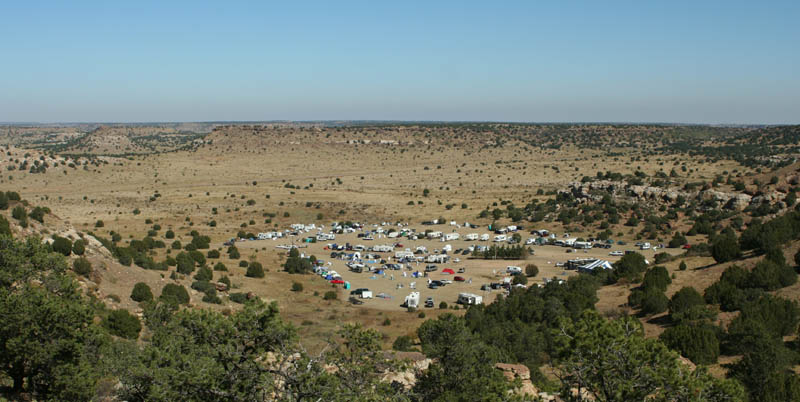
After we returned it was time for my talk about Bob Holmes' 32" F/4
fork-mounted, home-built research telescope, which I made the optic
for. After this I relaxed and chatted with friends.
Thursday night was our last night of observing, and when fog came in
around 2am we went to sleep.
Each night I also took a number of readings with a sky quality meter,
borrowed from John Stone. On Monday night, these were typically
around 21.7-21.8. On Tuesday, they were nearer to 21.9.
Wednesday night averaged around 21.8. Thursday night was
the best, with readings between 21.9 and 22.0. Folks, if you
don't know what that means, just rest assured that I confirmed that it
is DARK there.
We slept in Friday because we planned to drive non-stop back to
Illinois, leaving after
our talk about our 30" F/3.8
telescope, which we gave on Friday afternoon. At 4pm we were
on the road. We took route 56 this time, instead of 54, and it
was a much smoother road. After
one missed turn and one detour due to road construction, we rolled into
Dodge
City and fueled up our vehicle and our stomachs. Our conclusion
about
Dodge City was this - dodge it! It smelled funny and there wasn't
much
else to enjoy about it. We reached Kansas City, again in the
rain, and
cruised through Missouri overnight. We saw the aftermath of a
what had
been a very nasty accident on I-70 after crossing the Mississippi into
Illinois, and we
had breakfast about an hour later just south of Mattoon, IL. By
10am were back in Champaign, and by 11am we had unloaded our personal
items and had parted company.
All in all, this was an awesome trip. We plan to return next year
with an improved telescope. One night while we were there we
rotated
the primary mirror, and sure enough the astigmatism in the image
rotated
with the mirror. So, this winter I plan to refigure the mirror,
this
time on a machine with a flat turntable that can handle the stresses of
polishing a 30" mirror. Here is a final image, our 30" telescope
silhouetted
against the dark skies of Okie-Tex. (I have a bunch of panoramas
to stitch up that I may add later on, too.)
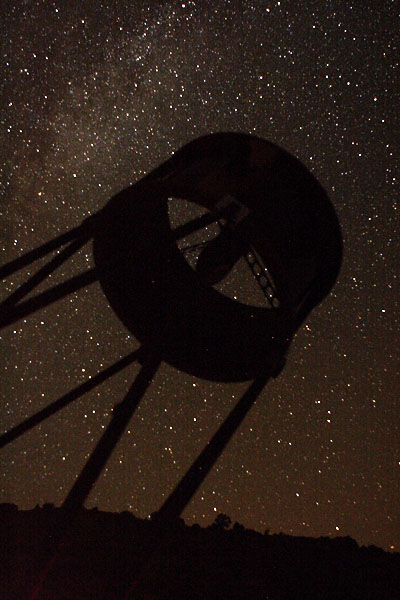
It was so nice to be under real dark skies again, for the first time
since I
left Michigan at the age of 15. It had been too long. I
will
be back.

























